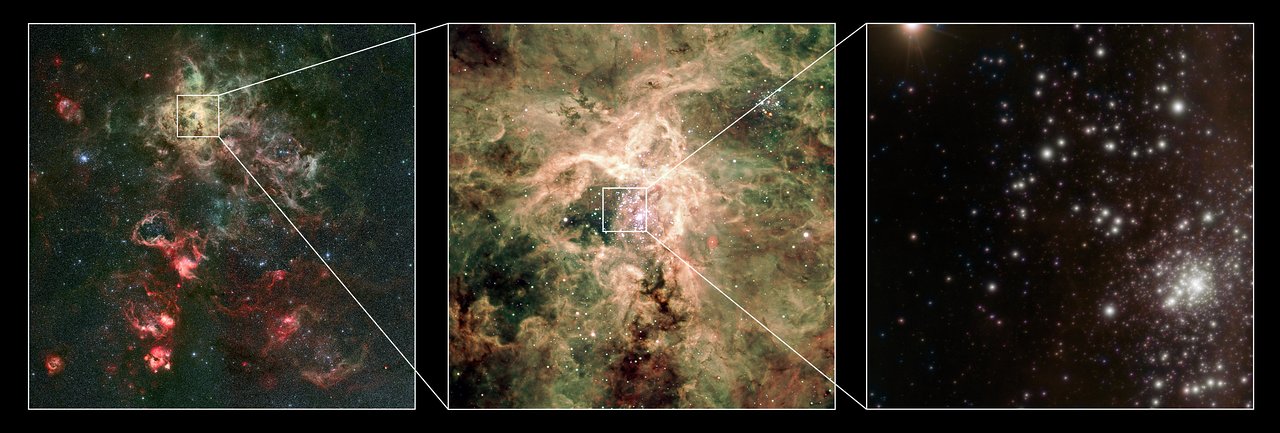Find out the latest thinking about our universe.
-
bystander
- Apathetic Retiree
- Posts: 21577
- Joined: Mon Aug 28, 2006 2:06 pm
- Location: Oklahoma
Post
by bystander » Wed Jul 21, 2010 2:33 pm
Stars Just Got Bigger: A 300 Solar Mass Star Uncovered
European Southern Observatory | Science Release eso1030 | 21 July 2010
Astronomers find a 300 solar mass star
Science and Technology Facilities Council | 21 July 2010
Royal Astronomical Society | 21 July 2010
Using a combination of instruments on ESO’s Very Large Telescope, astronomers have discovered the most massive stars to date, one weighing at birth more than 300 times the mass of the Sun, or twice as much as the currently accepted limit of 150 solar masses. The existence of these monsters — millions of times more luminous than the Sun, losing weight through very powerful winds — may provide an answer to the question “how massive can stars be?”
A team of astronomers led by Paul Crowther, Professor of Astrophysics at the University of Sheffield, has used ESO’s Very Large Telescope (VLT), as well as archival data from the NASA/ESA Hubble Space Telescope, to study two young clusters of stars, NGC 3603 and RMC 136a in detail. NGC 3603 (
eso1005) is a cosmic factory where stars form frantically from the nebula’s extended clouds of gas and dust, located 22 000 light-years away from the Sun. RMC 136a (more often known as R136) (
eso0613) is another cluster of young, massive and hot stars, which is located inside the Tarantula Nebula, in one of our neighbouring galaxies, the Large Magellanic Cloud, 165 000 light-years away.
The team found several stars with surface temperatures over 40 000 degrees, more than seven times hotter than our Sun, and a few tens of times larger and several million times brighter. Comparisons with models imply that several of these stars were born with masses in excess of 150 solar masses. The star R136a1, found in the R136 cluster, is the most massive star ever found, with a current mass of about 265 solar masses and with a birthweight of as much as 320 times that of the Sun.
In NGC 3603, the astronomers could also directly measure the masses of two stars that belong to a double star system
[1], as a validation of the models used. The stars A1, B and C in this cluster have estimated masses at birth above or close to 150 solar masses.
...
These super heavyweight stars are extremely rare, forming solely within the densest star clusters. Distinguishing the individual stars — which has now been achieved for the first time — requires the exquisite resolving power of the VLT’s infrared instruments
[2].
...
- The star A1 in NGC 3603 is a double star, with an orbital period of 3.77 days. The two stars in the system have, respectively, 120 and 92 times the mass of the Sun, which means that they have formed as stars weighing, respectively, 148 and 106 solar masses.
- The team used the SINFONI, ISAAC and MAD instruments, all attached to ESO’s Very Large Telescope at Paranal, Chile.
-
neufer
- Vacationer at Tralfamadore
- Posts: 18805
- Joined: Mon Jan 21, 2008 1:57 pm
- Location: Alexandria, Virginia
Post
by neufer » Wed Jul 21, 2010 2:42 pm
bystander wrote:
- Stars Just Got Bigger: A 300 Solar Mass Star Uncovered
European Southern Observatory | Science Release eso1030 | 21 July 2010
The team found several stars with surface temperatures over 40 000 degrees, more than seven times hotter than our Sun, and a few tens of times larger and several million times brighter. Comparisons with models imply that several of these stars were born with masses in excess of 150 solar masses. The star R136a1, found in the R136 cluster, is the most massive star ever found, with a current mass of about 265 solar masses and with a birth weight of as much as 320 times that of the Sun.
Such claims have been made before and it always turned out to be twins
(i.e., a double star systems orbiting perpendicular to the line of sight).
http://en.wikipedia.org/wiki/List_of_twins wrote:
<<The world's heaviest twins were born [in Arkansas] to John Prosser Haskin and Mary Ann Ward on Feb. 20, 1924.
They had a combined weight of 27 lb. 12 oz. Named John Prosser Haskin II and Patricia Jane Haskin.>>
 Mary Ann Ward is a descendant of
Mary Ann Ward is a descendant of
King Edward I "Longshanks" Plantagenet.
Art Neuendorffer
-
bystander
- Apathetic Retiree
- Posts: 21577
- Joined: Mon Aug 28, 2006 2:06 pm
- Location: Oklahoma
Post
by bystander » Wed Jul 21, 2010 3:16 pm
Biggest star ever found may be ticking antimatter bomb
New Scientist | Space | 21 July 2010
Just how humungous can a star be? One more massive than any other we know has been has been identified in a nearby galaxy. At more than 250 times the mass of the sun, it may one day explode in an exotic blast that involves the creation of antimatter.
R136a1 and a handful of other massive stars identified by the team could also be stars to watch, as they are candidates for an
exotic stellar death triggered by the creation of electrons and their antimatter counterparts. These explosions – called
pair-instability supernovae – are expected to rip apart stars and could explain the properties of some
recent bright supernovae.
Most Massive Star Discovered—Shatters Record
National Geographic | 21 July 2010
A newfound star has shattered the record as the most massive stellar monster ever seen, astronomers announced today.
Weighing in at a whopping 265 times the mass of our sun, the behemoth may have actually slimmed down since birth, when it likely tipped the scales at 320 times the sun's mass.
The discovery could rewrite the laws of stellar physics, since it's long been thought that stars beyond a certain mass would be too unstable to survive.
...
This stellar surprise, Parker said, might also add to evidence for a rare class of superviolent explosions known as pair-instability supernovae. (See "
Biggest Star Explosion Seen; Was Rare, 'Clean' Death.")
The most massive stars are generally thought to die in huge explosions that scatter the stars' outer layers but leave behind dense cores—either
neutron stars or
black holes.
-
Ann
- 4725 Å
- Posts: 13415
- Joined: Sat May 29, 2010 5:33 am
Post
by Ann » Wed Jul 21, 2010 5:41 pm
Really interesting. Personally I get a kick out of young massive luminous (and preferably blue!) stars, so this is very exciting news to me. Of course, Art may be right that the seemingly super-massive stars may really be more normal stars making up binaries or multiple stars.
Distinguishing the individual stars — which has now been achieved for the first time — requires the exquisite resolving power of the VLT’s infrared instruments[2].
Well, hmmm.... I guess infrared astronomy is good for certain things, then...


Ann
Color Commentator
-
neufer
- Vacationer at Tralfamadore
- Posts: 18805
- Joined: Mon Jan 21, 2008 1:57 pm
- Location: Alexandria, Virginia
Post
by neufer » Wed Jul 21, 2010 6:02 pm
Ann wrote:
Personally I get a kick out of young massive luminous (and preferably blue!) stars, so this is very exciting news to me. Of course, Art may be right that the seemingly super-massive stars may really be more normal stars making up binaries or multiple stars.
Distinguishing the individual stars — which has now been achieved for the first time
— requires the exquisite resolving power of the VLT’s infrared instruments.
Well, hmmm.... I guess infrared astronomy is good for certain things, then...


http://en.wikipedia.org/wiki/Very_Large_Telescope wrote:
<<The Very Large Telescope (VLT) is made up of four separate optical telescopes organized in an array formation on Cerro Paranal, a 2,635 m high mountain in the Atacama Desert in northern Chile. Each telescope has an 8.2 m aperture. The array is complemented by four movable Auxiliary Telescopes (ATs) of 1.8 m aperture. Working together in interferometric mode, the telescopes can achieve an angular resolution of around 1 milliarcsecond,
meaning it could distinguish the gap between the headlights of a car located on the Moon. This is comparable to the resolution achieved using other arrays such as the
Navy Prototype Optical Interferometer.>>
- VLT is infrared
NPOI is blue
All spooners on the moon
We now can see you. 
Art Neuendorffer
-
Beyond
- 500 Gigaderps
- Posts: 6889
- Joined: Tue Aug 04, 2009 11:09 am
- Location: BEYONDER LAND
Post
by Beyond » Wed Jul 21, 2010 6:14 pm
Galaxies speeding up, Stars becomeing more massive, kinda makes you wonder just what's going on that we can't see, which is a lot more than what we can see. Just what is the Cosmos up to, anyway??
To find the Truth, you must go Beyond.
-
neufer
- Vacationer at Tralfamadore
- Posts: 18805
- Joined: Mon Jan 21, 2008 1:57 pm
- Location: Alexandria, Virginia
Post
by neufer » Wed Jul 21, 2010 7:12 pm
beyond wrote:
Galaxies speeding up, Stars becomeing more massive, kinda makes you wonder
just what's going on that we can't see, which is a lot more than what we can see.
Just what is the Cosmos up to, anyway??
http://en.wikipedia.org/wiki/Cosmos wrote:
<<Pythagoras is said to have been the first philosopher to apply the term cosmos to the Universe, perhaps from application to the starry firmament. [However,] in its most general sense, a cosmos is an orderly or harmonious system. It originates from a Greek term κόσμος meaning "ordered world" and is the antithetical concept of chaos. The words cosmetics and cosmetology originate from the same root. In Mandarin Chinese, cosmos is translated as yuzhou, which literally translated means space-time (yu = space + zhou = time).
Russian cosmism is a philosophical position that mankind is an insignificant aspect of a universe at best indifferent and perhaps hostile. This philosophy, explored by writers such as H.P. Lovecraft and later writers who actually represented the beliefs in books such as Hitchhiker's Guide to the Galaxy.>>
Art Neuendorffer
-
orin stepanek
- Plutopian
- Posts: 8200
- Joined: Wed Jul 27, 2005 3:41 pm
- Location: Nebraska
Post
by orin stepanek » Fri Jul 23, 2010 4:01 am
Orin
Smile today; tomorrow's another day!
-
Beyond
- 500 Gigaderps
- Posts: 6889
- Joined: Tue Aug 04, 2009 11:09 am
- Location: BEYONDER LAND
Post
by Beyond » Sat Jul 24, 2010 5:28 am
neufer wrote:beyond wrote:
Galaxies speeding up, Stars becomeing more massive, kinda makes you wonder
just what's going on that we can't see, which is a lot more than what we can see.
Just what is the Cosmos up to, anyway??
http://en.wikipedia.org/wiki/Cosmos wrote:
<<Pythagoras is said to have been the first philosopher to apply the term cosmos to the Universe, perhaps from application to the starry firmament. [However,] in its most general sense, a cosmos is an orderly or harmonious system. It originates from a Greek term κόσμος meaning "ordered world" and is the antithetical concept of chaos. The words cosmetics and cosmetology originate from the same root. In Mandarin Chinese, cosmos is translated as yuzhou, which literally translated means space-time (yu = space + zhou = time).
Russian cosmism is a philosophical position that mankind is an insignificant aspect of a universe at best indifferent and perhaps hostile. This philosophy, explored by writers such as H.P. Lovecraft and later writers who actually represented the beliefs in books such as Hitchhiker's Guide to the Galaxy.>>
Makes me wonder why Carl Sagan used the word - Cosmos - so much.
To find the Truth, you must go Beyond.


